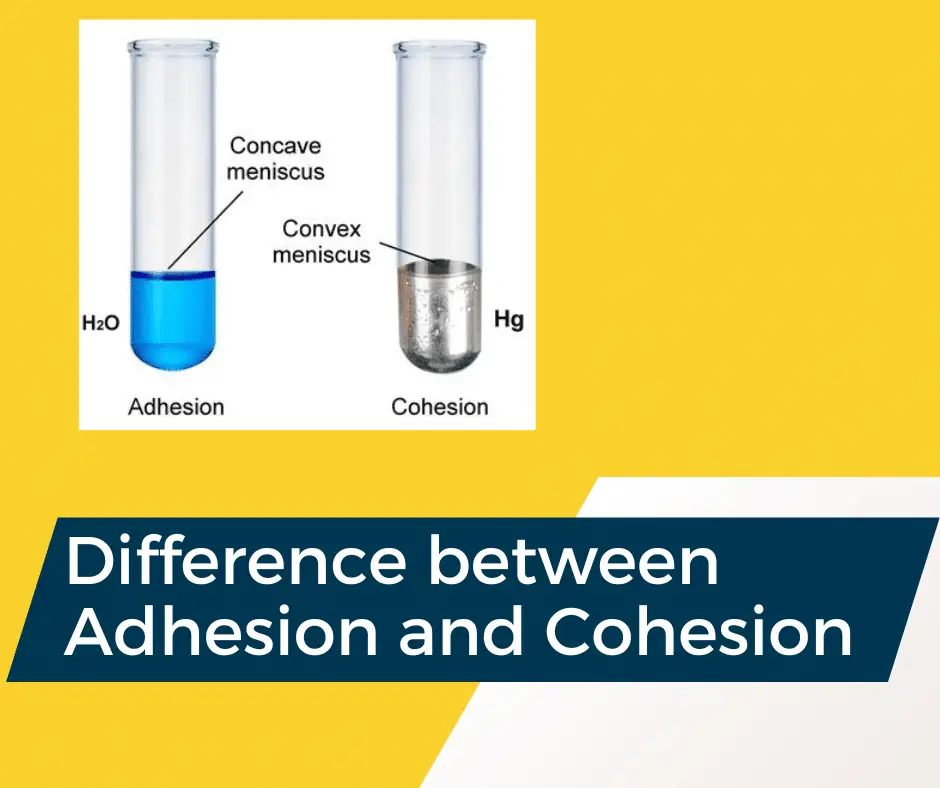Adhesion and cohesion are two important phenomena that are categorized as forces of attraction existing between different types of molecules in nature. Both adhesion and cohesion are correlated with each other by means of another physical phenomenon called surface tension.
Surface tension is defined as the kind of physical phenomenon in which the liquid molecules experience an inward force of attraction (cohesion), forcing the molecules at the surface to expand and appear flat on the surface level over a reduced surface area. Surface tension is represented by the symbol. Its SI unit is dynes per centimeter.
In this article, we will be discussing the difference between the two forces of attraction between the molecules namely – cohesion and adhesion.

But before that, we will look into what cohesion and adhesion are in general.
What is Cohesion?
Cohesion, also sometimes referred to as cohesive force is defined as the force of attraction existing between molecules of the same kind. Due to this reason, cohesion is also termed as an intermolecular force of attraction. In cohesion, the intrinsic molecules of the substance exert an equal force on another molecule of the same kind in all directions. Therefore, the net force is zero.
Cohesion is the reason for the spherical or round shape of liquid molecules like water. Liquids tend to retain their spherical shape due to the intermolecular force of attraction existing between the molecules termed as Van der Waals forces of attraction.
The cohesive force depends on the shape and atomic structure of the molecules of the substance. Therefore, the internal strength of the substance plays an important role in determining the cohesive forces of the given substance. Moreover, cohesion is not influenced by other external factors as it solely depends upon the force between the molecules within the substance.
For instance, the falling of rain on the earth’s surface in the form of spherical droplets is due to the cohesive property of water. In general, cohesion is responsible for the sticky nature of different water molecules.
What is Adhesion?
Adhesion is referred to as the physical property of substances exhibiting a force of attraction between molecules of different types or between molecules of two different substances. Due to this reason, adhesion is also termed an intramolecular force of attraction.
For instance, when a water molecule falls on the surface, it spreads and appears to be flattened at the bottom, this is because of the adhesive force acting between the water molecule and the other substance, which results in the stretching of the water molecule at the surface.
Some other examples of adhesive substances include glue, paint, cement, etc. The spilling of liquid on a surface is also due to the presence of adhesive force, which exists due to the presence of electrostatic force or mechanical force. Adhesive, adherend, and surface are the three important terms that are closely interrelated to each other. An interface is formed between the adhesive force and the adherend when an adhesive bond is created called the transitional zone.
The interface zone is constituted of a unique type of physical properties that sets it apart from the adhesive and adherend regions. Another example of adhesive force in nature is the condensed water droplets on the surface of leaves or the upward movement of water in plant stems due to the adhesive force between the water molecules and the walls of the plant stem.
Difference between Adhesion and Cohesion
The key differences between adhesion and cohesion are listed in the following table given below.
| Parameter | Adhesion | Cohesion |
| Definition | It exists between molecules of different kinds between two different substances. | It exists between molecules of the same kind within the substance. |
| Type of attractive force | Intramolecular attraction force exists between the molecules experiencing adhesive force. | An intermolecular attraction force exists between the molecules experiencing cohesive force. |
| Type of force | Adhesion exists due to the presence of electrostatic force between the molecules of two different substances. | Cohesion exists due to the presence of Van der Waals force between the molecules of two different substances. |
| Property | The substance spreads or spills on the surface. | Cohesion results in the formation of water droplets. |
| Effects | The effects of adhesion include – Capillary action and meniscus. | The effects of cohesion include – Surface tension, capillary action, and meniscus. |
| Strength of the attraction force | The adhesive forces are much stronger than the cohesive force due to the stronger electrostatic force between the molecules. | The cohesive force is comparatively weaker than the adhesive force due to the presence of a weak Van der Waals force of attraction. |
| Examples | Water drops present on the leaf’s surface, upward conduction of water in plants, etc. | Storage of liquid in containers, rain droplets falling on the earth’s surface, etc. |
Conclusion
In conclusion, cohesion and adhesion are two important physical phenomena associated with the bond formation or interaction of different molecules with each other by means of existing forces. The main difference between them is that cohesion is the intermolecular force existing between molecules of the same kind. While adhesion is the intramolecular force of attraction existing between molecules of two different substances. This phenomenon of cohesion and adhesion are correlated to each other via another physical phenomenon called surface tension, which is usually observed at the water surface in oceans or seas.